
U.S. Senate passes Equal Rights Amendment in 1972 (The Daily Times, via Newspapers.com)
The Equal Rights Amendment (ERA) is a proposed amendment to the U.S. Constitution. The first section, as passed by the U.S. Congress in 1972, states “Equality of rights under the law shall not be denied or abridged by the United States or by any State on account of sex.”
History & Background
The ERA (sometimes called the “Lucretia Mott Amendment” or “Alice Paul Amendment”) had its genesis in the 1920s. After the 19th Amendment granted women the right to vote, women’s rights activists turned their attention to passing a Constitutional amendment that would guarantee equal rights regardless of gender.
Led by Alice Paul, head of the National Woman’s Party, the Equal Rights Amendment was first introduced to Congress in 1923. The text of the amendment as it currently stands was written by Paul in 1943. In its early years, the ERA was notably opposed by working women, who worried that the amendment would eliminate protections women had gained in the workplace.
For many decades, no progress was made in passing the ERA in Congress. However, the 1960s, with its focus on women’s rights, saw a renewed push for the amendment. The ERA was finally passed by the House of Representatives on October 12, 1971, and by the Senate on March 22, 1972.
Ratification
After its passage in Congress, the Equal Rights Amendment was sent to the state legislatures for ratification. Thirty-eight states would have to ratify the amendment to achieve the mandatory three-fourths majority; Congress also imposed a 7-year ratification deadline.
The first year saw many states pass the amendment, creating the expectation of a quick ratification process. However, social conservatives mobilized in opposition to the ERA, drastically slowing ratification in the remaining states.
In 1978, Congress extended the ERA’s deadline to 1982, but the amendment still lacked ratification by the necessary number of states. After 1977, no further states ratified the ERA until 2017 (Nevada), 2018 (Illinois), and Virginia (2020), raising the total to 38 states.
Learn more about the Equal Rights Amendment through historical newspapers from our archives. Explore newspaper articles, headlines, images, and other primary sources below.
Articles and Clippings about the Equal Rights Amendment
 "Catholic Women Tell Why They Oppose 'Equal Rights' Amendment to Constitution" in 1923 Sat, Aug 4, 1923 – Page 16 · The Catholic Advance (Wichita, Kansas) · Newspapers.com
"Catholic Women Tell Why They Oppose 'Equal Rights' Amendment to Constitution" in 1923 Sat, Aug 4, 1923 – Page 16 · The Catholic Advance (Wichita, Kansas) · Newspapers.com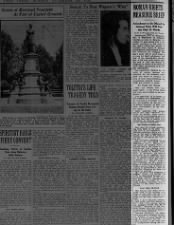 Activists launch "campaign in behalf of the proposed equal rights amendment" in November 1923 Sun, Nov 11, 1923 – Page 59 · Detroit Free Press (Detroit, Michigan) · Newspapers.com
Activists launch "campaign in behalf of the proposed equal rights amendment" in November 1923 Sun, Nov 11, 1923 – Page 59 · Detroit Free Press (Detroit, Michigan) · Newspapers.com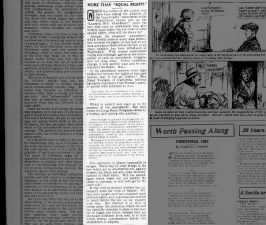 1923 editorial says ERA "may give women equal rights but rob them of some special rights" Tue, Dec 25, 1923 – Page 20 · The San Bernardino County Sun (San Bernardino, California) · Newspapers.com
1923 editorial says ERA "may give women equal rights but rob them of some special rights" Tue, Dec 25, 1923 – Page 20 · The San Bernardino County Sun (San Bernardino, California) · Newspapers.com "Women Voters Are Not of One Mind on the Mott Amendment" Wed, Jan 30, 1924 – Page 7 · The Morning News (Wilmington, Delaware) · Newspapers.com
"Women Voters Are Not of One Mind on the Mott Amendment" Wed, Jan 30, 1924 – Page 7 · The Morning News (Wilmington, Delaware) · Newspapers.com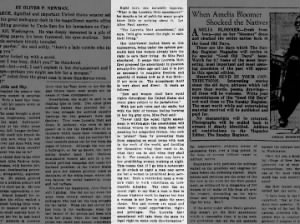 Quotes from Alice Paul in 1926 about the Equal Rights Amendment Sun, Feb 21, 1926 – Page 62 · The Des Moines Register (Des Moines, Iowa) · Newspapers.com
Quotes from Alice Paul in 1926 about the Equal Rights Amendment Sun, Feb 21, 1926 – Page 62 · The Des Moines Register (Des Moines, Iowa) · Newspapers.com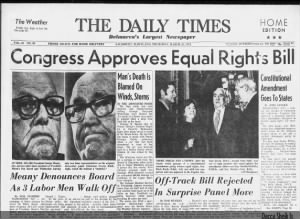 Front page news about the U.S. Senate approving the Equal Rights Amendment in 1972 Thu, Mar 23, 1972 – 1 · The Daily Times (Salisbury, Maryland) · Newspapers.com
Front page news about the U.S. Senate approving the Equal Rights Amendment in 1972 Thu, Mar 23, 1972 – 1 · The Daily Times (Salisbury, Maryland) · Newspapers.com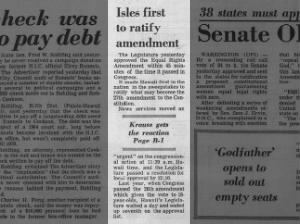 Hawaii becomes first U.S. state to ratify the Equal Rights Amendment Thu, Mar 23, 1972 – 1 · The Honolulu Advertiser (Honolulu, Hawaii) · Newspapers.com
Hawaii becomes first U.S. state to ratify the Equal Rights Amendment Thu, Mar 23, 1972 – 1 · The Honolulu Advertiser (Honolulu, Hawaii) · Newspapers.com Political cartoon from 1972 about the Equal Rights Amendment Thu, Mar 23, 1972 – Page 1 · The Indianapolis Star (Indianapolis, Indiana) · Newspapers.com
Political cartoon from 1972 about the Equal Rights Amendment Thu, Mar 23, 1972 – Page 1 · The Indianapolis Star (Indianapolis, Indiana) · Newspapers.com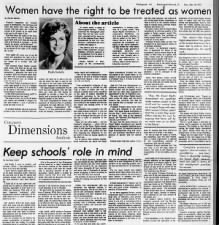 Anti-ERA activist Phyllis Schlafly writes op-ed opposing the Equal Rights Amendment Sun, Dec 10, 1972 – Page 5 · The Pantagraph (Bloomington, Illinois) · Newspapers.com
Anti-ERA activist Phyllis Schlafly writes op-ed opposing the Equal Rights Amendment Sun, Dec 10, 1972 – Page 5 · The Pantagraph (Bloomington, Illinois) · Newspapers.com 1973 article considering arguments for and against passing the Equal Rights Amendment in Utah Sun, Jan 14, 1973 – 77 · The Salt Lake Tribune (Salt Lake City, Utah) · Newspapers.com
1973 article considering arguments for and against passing the Equal Rights Amendment in Utah Sun, Jan 14, 1973 – 77 · The Salt Lake Tribune (Salt Lake City, Utah) · Newspapers.com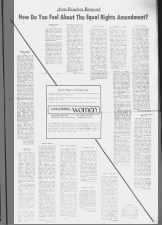 North Carolinians respond the the question "How do you feel about the Equal Rights Amendment?" Sun, Feb 11, 1973 – 33 · Rocky Mount Telegram (Rocky Mount, North Carolina) · Newspapers.com
North Carolinians respond the the question "How do you feel about the Equal Rights Amendment?" Sun, Feb 11, 1973 – 33 · Rocky Mount Telegram (Rocky Mount, North Carolina) · Newspapers.com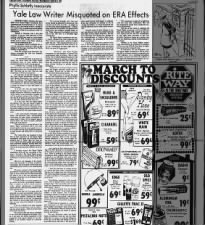 Law professor addresses what he considers to be misconceptions about the Equal Rights Amendment Wed, Mar 14, 1973 – Page 5 · The Republic (Columbus, Indiana) · Newspapers.com
Law professor addresses what he considers to be misconceptions about the Equal Rights Amendment Wed, Mar 14, 1973 – Page 5 · The Republic (Columbus, Indiana) · Newspapers.com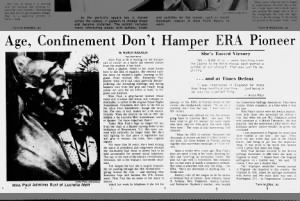 Excerpt from 1977 article about Alice Paul's work on the Equal Rights Amendment Tue, Mar 22, 1977 – Page 5 · The Palm Beach Post (West Palm Beach, Florida) · Newspapers.com
Excerpt from 1977 article about Alice Paul's work on the Equal Rights Amendment Tue, Mar 22, 1977 – Page 5 · The Palm Beach Post (West Palm Beach, Florida) · Newspapers.com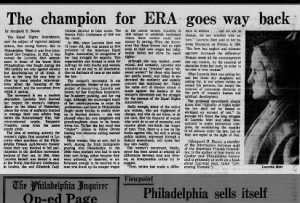 1977 op-ed discusses Lucretia Mott's ties to the Equal Rights Amendment Fri, May 27, 1977 – Page 11 · The Philadelphia Inquirer (Philadelphia, Pennsylvania) · Newspapers.com
1977 op-ed discusses Lucretia Mott's ties to the Equal Rights Amendment Fri, May 27, 1977 – Page 11 · The Philadelphia Inquirer (Philadelphia, Pennsylvania) · Newspapers.com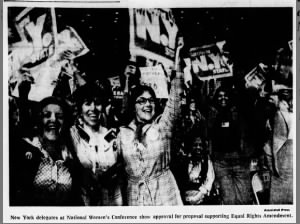 Photo of New York delegates at the National Women's Conference showing support for the ERA Mon, Nov 21, 1977 – Page 2 · Arizona Republic (Phoenix, Arizona) · Newspapers.com
Photo of New York delegates at the National Women's Conference showing support for the ERA Mon, Nov 21, 1977 – Page 2 · Arizona Republic (Phoenix, Arizona) · Newspapers.com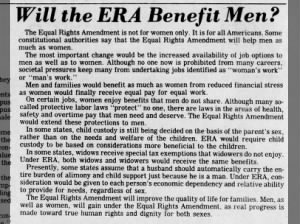 Opinion that the Equal Rights Amendment would benefit men as well as women Sun, May 13, 1979 – 57 · Arizona Daily Sun (Flagstaff, Arizona) · Newspapers.com
Opinion that the Equal Rights Amendment would benefit men as well as women Sun, May 13, 1979 – 57 · Arizona Daily Sun (Flagstaff, Arizona) · Newspapers.com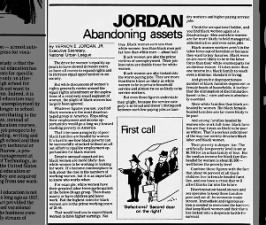 Opinion that women's rights discussions center on ERA and ignore "plight of black women" Thu, Oct 18, 1979 – 10 · The Morning Call (Allentown, Pennsylvania) · Newspapers.com
Opinion that women's rights discussions center on ERA and ignore "plight of black women" Thu, Oct 18, 1979 – 10 · The Morning Call (Allentown, Pennsylvania) · Newspapers.com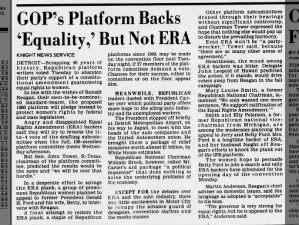 Republican Party removes support for the ERA from their party platform in 1980 Wed, Jul 9, 1980 – Page 1 · The Cincinnati Enquirer (Cincinnati, Ohio) · Newspapers.com
Republican Party removes support for the ERA from their party platform in 1980 Wed, Jul 9, 1980 – Page 1 · The Cincinnati Enquirer (Cincinnati, Ohio) · Newspapers.com Jesse Jackson argues that African Americans should support ERA while still fighting racism Fri, Aug 1, 1980 – Page 19 · The News Journal (Wilmington, Delaware) · Newspapers.com
Jesse Jackson argues that African Americans should support ERA while still fighting racism Fri, Aug 1, 1980 – Page 19 · The News Journal (Wilmington, Delaware) · Newspapers.com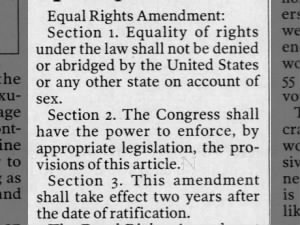 Text of the 1972 Equal Rights Amendment (ERA) Tue, Mar 7, 2006 – Page 6 · Battle Creek Enquirer (Battle Creek, Michigan) · Newspapers.com
Text of the 1972 Equal Rights Amendment (ERA) Tue, Mar 7, 2006 – Page 6 · Battle Creek Enquirer (Battle Creek, Michigan) · Newspapers.com Nevada becomes first state in 40 years to ratify the Equal Rights Amendment Thu, Mar 23, 2017 – A1 · Reno Gazette-Journal (Reno, Nevada) · Newspapers.com
Nevada becomes first state in 40 years to ratify the Equal Rights Amendment Thu, Mar 23, 2017 – A1 · Reno Gazette-Journal (Reno, Nevada) · Newspapers.com